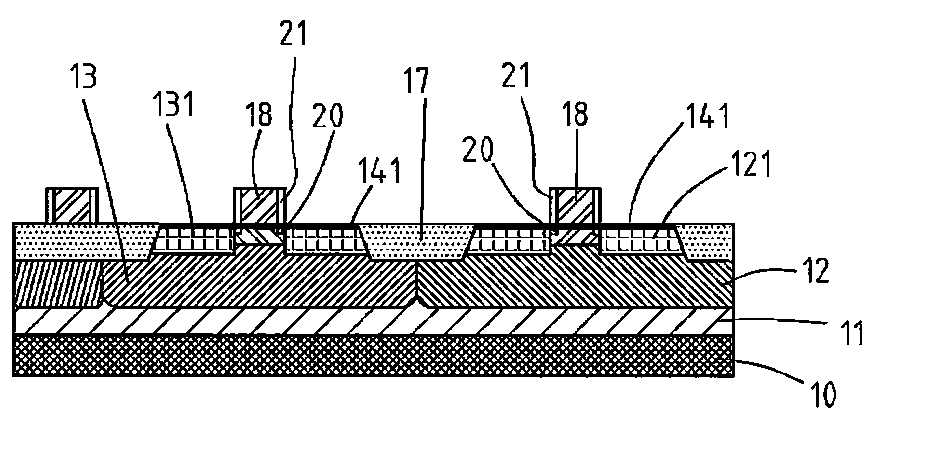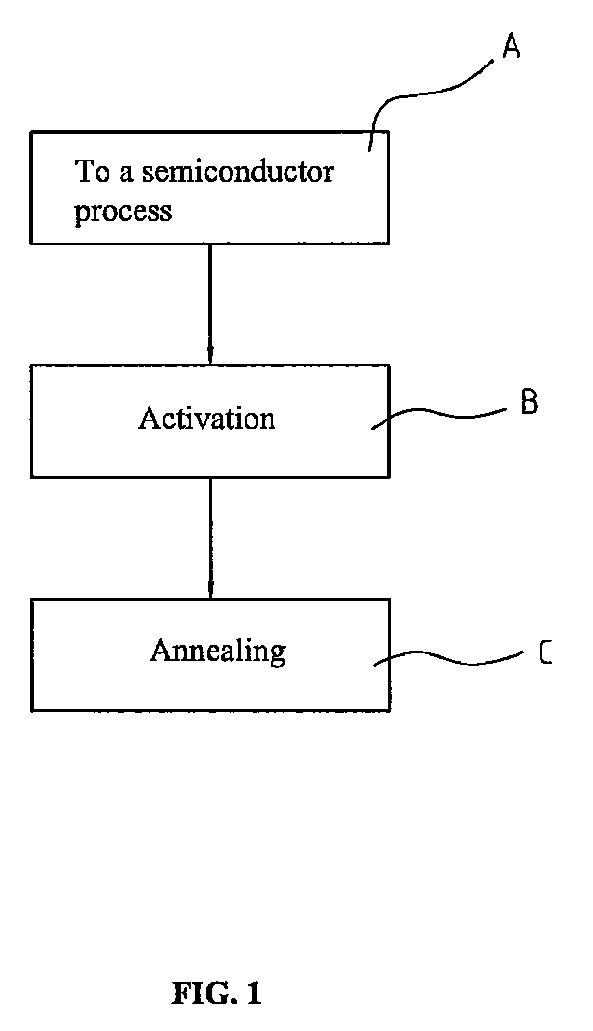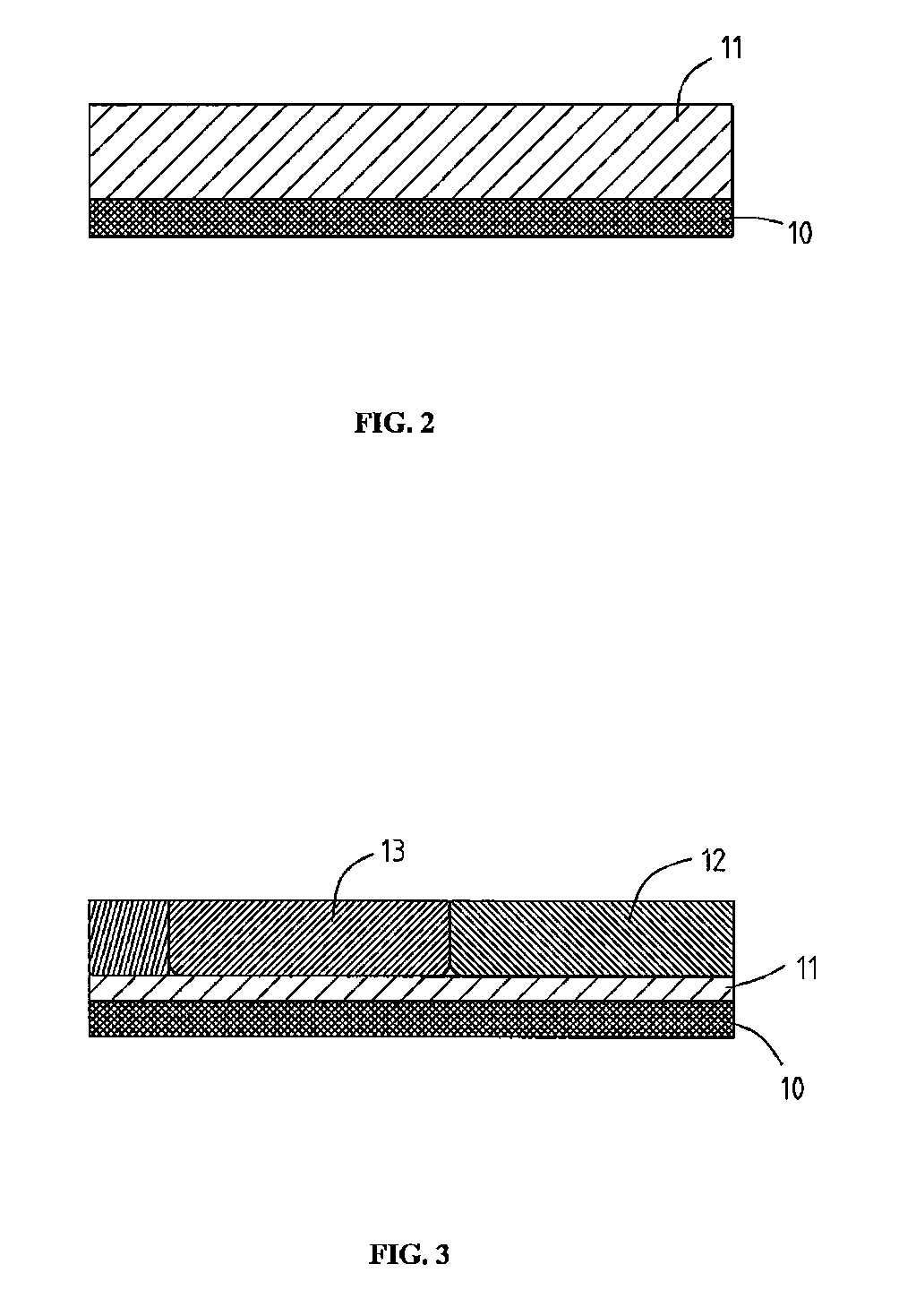Microwave activation annealing process
a technology of activation and annealing process, which is applied in the direction of semiconductor devices, electrical apparatus, transistors, etc., can solve the problems of degrading process efficiency, limiting the duration of the work object on the high temperature generated in the activation procedure of the process, and generating thermal destruction on the object to be manufactured, etc., to achieve high electron mobility, provide energy in a very quick way, and high efficiency
- Summary
- Abstract
- Description
- Claims
- Application Information
AI Technical Summary
Benefits of technology
Problems solved by technology
Method used
Image
Examples
first embodiment
[0044]Please refer to FIG. 2 to FIG. 7, which is the present invention; in the embodiment, the microwave activation annealing process of the present invention is applied in Complementary Metal Oxide Semiconductor Field Effect Transistor process; as shown in FIG. 2, silicon-based substrate is supplied to be used as P type bare wafer (10) and the P type bare wafer (10) is cleaned, then epitaxy deposition is performed to form a P type epitaxial layer (11); as shown in FIG. 3, photo mask is used on the P type epitaxial layer (11) to perform microlithography process so as to form a N well (12); meanwhile, the N well (12) is implanted with P ion, and a photo mask is further used on the P type epitaxial layer (11) to perform microlithography process to form P type well (13), then the P type well (13) is implanted with boron ion, and finally the photo resist is stripped.
[0045]As shown in FIG. 4, above the N type well (12) and the P type well (13) is made with an pad oxide layer (14); meanwh...
second embodiment
[0051]Please refer to FIGS. 8 to 10, which is the present invention; in the embodiment, the microwave activation annealing process of the present invention is used in Metal Semiconductor Field Effect Transistor process; as shown in FIG. 8, a compound substrate of GaAs semi-insulating substrate (30) is supplied, epitaxial way is used to stack in sequence a buffer layer (31), a Schottky layer (32) and a cap layer (33); then dry etching method is used to do dicing and mesa isolation to form several mutually separated blocks.
[0052]As shown in FIG. 9, on the cap layer (33) of one of the blocks, the microlithography process is used to form metal contact between the source electrode (34) and the drain electrode (35); then the microwave activation annealing is performed with microwave activation frequency of 5.8 GHz and microwave activation temperature of 320° C., and the microwave annealing frequency can also be 5.8 GHz with microwave annealing temperature also 320° C., hence the contact r...
third embodiment
[0054]Please refer to FIG. 11 to FIG. 14, which is the present invention; in the embodiment, the microwave activation annealing process of the present invention is used in a Thin Film Transistor process; as shown in FIG. 11, a glass substrate (40) is supplied and glass inspection is done to inspect if there are any defects on the glass substrate (40); then chemical vapor deposition (CVD) is used to deposit a silicon dioxide buffer layer (41) and on the silicon dioxide buffer layer (41) is then deposited again with a hydrogenated amorphous silicon (a-Si:H)(42); then a dehydrogenation step is used to strip off the hydrogen in the hydrogenated amorphous silicon (42).
[0055]As shown in FIG. 12, then the next thing to do is crystallization, then the definition and etching of ploy-Si island (43) is done. As shown in FIG. 13, CVD is used to perform gate electrode dielectric layer deposition so as to form a gate dielectric layer (44) to cap poly-silicon island (43), then deposition and etchi...
PUM
 Login to View More
Login to View More Abstract
Description
Claims
Application Information
 Login to View More
Login to View More - R&D
- Intellectual Property
- Life Sciences
- Materials
- Tech Scout
- Unparalleled Data Quality
- Higher Quality Content
- 60% Fewer Hallucinations
Browse by: Latest US Patents, China's latest patents, Technical Efficacy Thesaurus, Application Domain, Technology Topic, Popular Technical Reports.
© 2025 PatSnap. All rights reserved.Legal|Privacy policy|Modern Slavery Act Transparency Statement|Sitemap|About US| Contact US: help@patsnap.com



